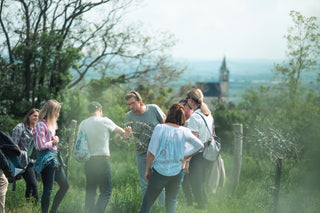

the mission of our agriculture
To establish the olive as a cultivated plant in Austria
What's behind Pannolio is more than just a crazy idea.
Even though the olive tree and the production of olive oil is viewed as traditional agricultural work in Austria, industrialization has not stopped at this product either. Over the last few decades, due to political arbitrariness or simply cheap mass-produced products, many olive varieties have been lost or only a few people care about preserving the old varieties. Dumping products with a uniform taste are the downfall of diversity.

One of the oldest cultivated plants in the world
- yet hardly anyone in Austria knows about olive culture. We must banish ignorance about the olive from people's minds once and for all.
Research into the olive in our latitudes
We have already collected over 130 winter-hardy olive varieties and planted them in a wide variety of locations. We are constantly coming across new findings that will be very relevant for the planting of olives in the Pannonian region. Based on our findings, we are expanding our online shop to include the varieties that have already proven themselves to be successful for us.
Network of olive farmers with knowledge database
Around a dozen farmers are already part of our cooperative and work with us to plant olive trees in the best vineyards in Austria. These include the Wachau, southern Styria, Leithaberg and Seewinkel. Through a lively exchange with each other, we can reach our goals more quickly together.

Visit one of our olive groves at our
Olive Experience
During our olive experience, learn things about the olive tree that hardly anyone in Austria knows. In our workshop, with a tour of the grove and a subsequent culinary conclusion to olive cultivation, we will teach you everything over the course of the evening why you don't have to be afraid of the olive tree, and reveal why olive cultivation in the Pannonian region is very different from Italy or Spain.
Our olive groves
That's part of our mission
In contrast to wine, there are different types of olives
Distinctive features often refer to the origin of a single plant
or a small village with very special climatic conditions
can be traced back - thousands of varieties have developed over time
developed which we plant, collect and use in our olive garden
then propagate it via cuttings and offer it for sale so that we can
with the greatest commitment to protect these rarities and
give them a new home in Austria.
Production of olive oil
The supreme discipline - because there are currently thousands of varieties
around 70 that can survive a harsh Pannonian winter. Of that
There are many types of olives for oil production and of course
large, pulp-rich table olives. Every olive tastes good
different, has a different oil content and different
Compositions of polyphenols must be at different times
harvested and ultimately at different concentrations
cuveeted to create a unique olive oil.

